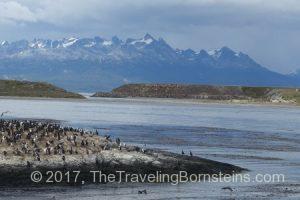
While I was growing up in Highland Park, Illinois, I’d occasionally walk a few blocks east to Lake Michigan. In the spring and fall, the beach offered peace and solitude from my everyday world. I would watch the waves ripple toward the sandy beach from an unknown place. Sometimes ferocious whitecaps would pound the land and submerge the sand under the water.
Even though I couldn’t see the Michigan shoreline, I knew it was on the other side of the lake. Twentieth century maps provided concrete evidence that the water didn’t go on indefinitely. I couldn’t fathom a time when parts of the world remained uncharted or when people believed the world was flat.
As a middle aged woman, I traveled on the Celebrity Cruise ship Infinity from Buenos Aires, Argentina to Valparaiso, Chile. I was eager to get a sampling of South America on this two-week, 4500+ mile cruise. Based on previous sailings, I knew that my cruise experience would be like a smorgasbord. I would taste a little bit of this and a little bit of that.
My lasting impressions of South American are based on the tidbits of information that I
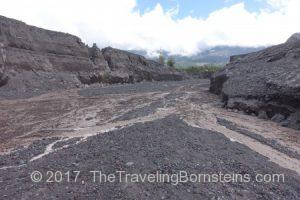
gathered during onshore excursions. I stood in silence at a beachfront Holocaust memorial in Uruguay, had a one-on-one encounter with Magellanic penguins at the El Pedral Lodge in Puerto Madryn, Argentina, gawked at marine wildlife on a small boat excursion on the Beagle Channel near Ushuaia, and hiked 6 kilometers on the Sendero El Solitario, a volcanic trail in the Parque Nacional Vicente Perez Rosales in Puerto Montt, Chile. These images are just a smattering of what I experienced.
On a typical cruise, the emphasis is on onshore itineraries. Passengers can select from oodles and oodles of prearranged group and private tours or explore on their own. Unless the weather isn’t cooperating, most passengers disembark to explore.
Days at sea are usually more laid back and carefree. Some choose to relax in their cabin or at the spa. In warmer climates, people clamor for their spot around the pool. A full schedule of activities engages the rest of the passengers while a never-ending selection of food keeps most fully satiated.
Rounding Cape Horn
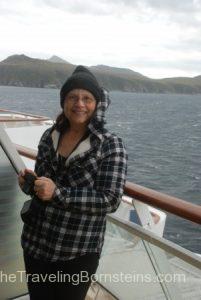
The Rounding Cape Horn itinerary offers a totally different cruise experience. In the heart of a North American winter, passengers board the ship wearing summer outfits and exit wearing similar attire. For the first few days, the temperature remains comfortable. As the ship heads south, the temperature decreases. From Madryn to Ushuaia, the temperature dropped approximately ten degrees every twelve hours. Rougher waters and sharper winds accompany the decrease in temperature. When the ship heads up the Chilean coast, the opposite occurs. It stays chilly for a while and then quickly warms up. Experiencing this drastic change in climate and terrain increased my curiosity. Deep down I knew that this cruise would be unique since each day expose me to something new.
I was looking forward to sailing around Cape Horn. Other than knowing that many had died during their attempt, I didn’t know what to expect. After all weren’t those courageous explorers and sailors traveling through an uncharted territory in small wooden ships? Their rudimentary navigational tools lacked the sophistication of modern technology and maps were in short supply.
Being in a mega cruise ship, I knew that my journey would be considerably more comfortable and safer. Even though my ship had the advantages of modern living, our ship encountered a head-to-head match with Mother Nature.
Approaching Cape Horn, the seas were calm with 30-knot winds. Clouds and mist at times limited our visibility. We were in an area of the world where it’s common to have 278 days of precipitation. This location stands in sharp contrast to the mostly sapphire blue skies that grace Colorado for approximately 300-days a year.
A few albatross were flying slightly ahead of our vessel. Mickey, Celebrity Cruises’ onboard maven, told everyone that this was a sign of good luck. By the time, our ship reached Cape Horn the winds had picked up. Fifteen foot swales and 70-mile per hour winds blasted our ship. Waves crashed up against the steep terrain that bordered the waterway.
The captain skillfully guided the ship around Cape Horn a few times so that everyone had a chance to view the landmark that is located on the Isla Hormos. We were less than 500 miles north of Antarctica and at the northern boundary of the Drake Passage, the place where the Atlantic and Pacific Oceans meet. This ocean thoroughfare is nowadays used for commercial ships.
As our balcony furniture scampered across the deck in unison with the rocking of the boat, we squinted and looked across the water to the small island that had an albatross sculpture, a few
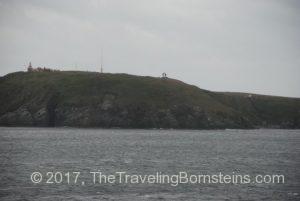
buildings and a lighthouse. We squinted. The lens on our cameras had a much better view. The cruise ship continued on its course through the choppy waters while we had to steady our footing to adjust to the rolling motion. Stabilizers could only offset a portion of the intense movements.
Many of our fellow passengers remained bundled up inside and didn’t cope well with the up and down motion. During the most tumultuous times, there were many empty places in the main dining room.
Early Explorers
I couldn’t stop thinking about what it must have been like for the early explorers who navigated with limited resources through these treacherous waters. If our massive cruise ship bounced to and fro like a toy boat, how did those explorers cope in their modest sailboats?
Magellan’s words speak for that era of brave men. “The sea is dangerous and its storms terrible, but these obstacles have never been sufficient reason to remain ashore…unlike the mediocre, intrepid spirits seek victory over those things that seem impossible…it is with an iron will that they embark on the most daring of all endeavors…to meet the shadowy future with fear and conquer the unknown.”
Today’s passengers can only imagine the explorer’s triumphs and defeats. But at the same time, everyone who visits can enjoy the immense beauty of this less traveled region that is known for its channels, straits, fjords, and glaciers.
Ushuaia
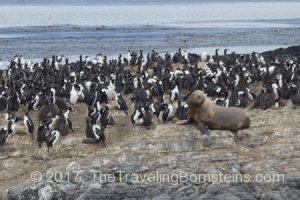
The next morning, we awoke to calm waters with a horizon painted with a multicolored sunrise. Our ship floated peacefully at the base of Ushuaia. The high point of the day was a short boat excursion on the Beagle Channel which is located in the Tierra del Fuego Archipelago in both Argentina and Chile. While most of the small boat passengers couldn’t handle the blustery wind, Ira and I walked back and forth in the outdoor sections trying to capture the best photos possible.
Being with birds and animals in their water habitat, hooked me on marine wildlife adventures. The towering peaks that framed the waterways added another layer to my spiritual connection with nature.
Glacier Fields, Straits, Channels, and Fjords
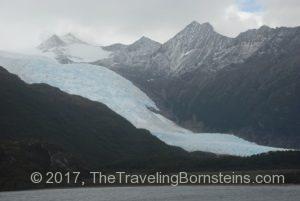
The daily Celebrity bulletin provided the approximate times that we would pass by notable landmarks such as the Darwinian Glacier Fields, the Straits of Magellan, and the Chilean Fjords. The estimates were usually not exact. I oftentimes shivered outside and then defrosted in our cabin.
After all of the hype about the Darwin’s Glacier fields (Cordillera Darwin), I didn’t want to miss one of nature’s spectacular creations. Almost two centuries ago, Darwin had recorded his observations by stating, “It is scarcely possible to imagine anything more beautiful than the beryl-like blue of these glaciers, and especially as contrasted with the dead white of the upper expanse of snow.”
Our cruise ship navigated through the Beagle Channel, named after Darwin’s ship, the HMS Beagle and then came upon this series of famous glaciers on the starboard side. It was indeed worth the wait.
Eventually, we headed north to Punta Arenas where we stayed for a day. Thereafter, we headed toward the Chilean Archipelago Reina Adefalda. Along the way, we sailed though a portion of the Strait of Magellan, a channel that links together the Atlantic and Pacific Oceans. While the journey around Cape Horn is known for its treacherous waters, the Strait of Magellan is notorious for its narrow passages and unpredictability.
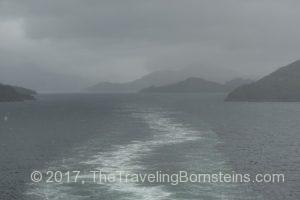
We hopscotched between a series of narrow passageways in the archipelago that were labeled fjords and the Pacific Ocean. The Chilean islands were numerous and varied in size. It was like traveling through a complex maze comprised of islands. Time became nonexistent as we took time to appreciate the natural resources of this area and rarely bothered to look at our watches. We spent most of our time staring past our rear facing deck.
Now, more than ever, I can appreciate Jacques Yves Coutsteau’s words, The sea, once it casts its spell, holds one in its net of wonder forever.”
CAN YOU SHARE?
Have you ever been on a cruise where the sea days were as exciting as the port days?
RELATED POSTS
A Day at the End of the World: Visiting the City of Ushuaia, Argentina
Uruguay: The Overlooked Beachy Paradise of South America
Four Reasons You Need to Head to Patagonia for a Penguin Adventure
A Guide to Buenos Aires for When You Don’t Have Long to Visit
What Cruisers Should Know About Multiple Days in Tianjin, China
Rio Frio Fascinates Nature Lovers in Costa Rica
Costa Rica Whitewater rafting along the Rio Sarapiqui
Zip-lining in Costa Rica—exhilarating
Poás Volcano National Park, Costa Rica
BIO
Sandra Bornstein is a freelance travel and lifestyle writer. She shares her experiences and recommendations on this blog and on other websites. Check out Sandra’s second website, https://thetravelingbornsteins.com. It exclusively focuses on travel.
Sandra contributes a monthly travel tip column for Golden Living, a Best Version Media magazine. She also writes for Fareportal’s online sites—One Travel Going Places and CheapOAir Miles Away.
Sandra is the author of MAY THIS BE THE BEST YEAR OF YOUR LIFE. This memoir highlights Sandra’s living and teaching adventure in Bangalore, India. As a licensed Colorado teacher, Sandra has taught K-12 students in the United States and abroad. She also taught college level courses.
Sandra’s memoir was a finalist in the Travel category for the 2013 Next Generation Indie Book Awards, the 2013 International Book Awards, the 2013 National Indie Book Excellence Awards, 2013 USA Best Book Awards, and a Honorable Mention award in the Multicultural Non-Fiction category for the 2013 Global ebook Awards.
I think I’ve almost convinced my husband we should go on this cruise. We have visited both Chile and Argentina and we’ve seen the Cape of Good Hope at the end of Africa, but we’ve never visited the southern most parts of Chile and Argentina. This winter, were checking the Galapagos off his bucket list. I’ll share your post with him and maybe next year, we’ll check the Horn off mine.
Suzanne, There is something very special about traveling around Cape Horn and also visiting the Darwinian Glacier Fields, Straits of Magellan, and the Chilean Fjords. If you end up going, I’d love to hear your reaction. After you visit the Galapagos, I’d be interested in hearing about your experience. We are planning to go the end of 2018.